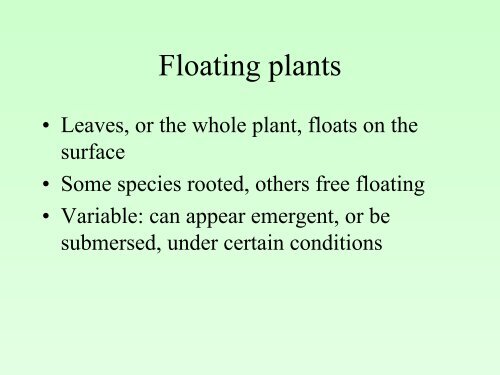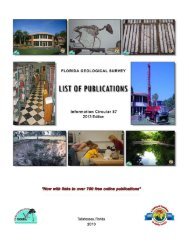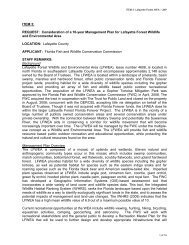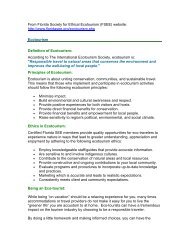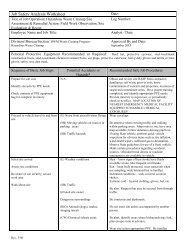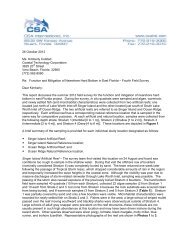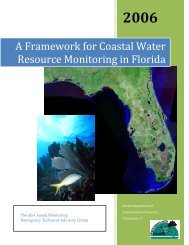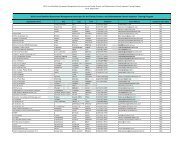Hydrilla verticillata hydrilla, water thyme
Hydrilla verticillata hydrilla, water thyme
Hydrilla verticillata hydrilla, water thyme
Create successful ePaper yourself
Turn your PDF publications into a flip-book with our unique Google optimized e-Paper software.
• Leaves, or the whole plant, floats on the<br />
surface<br />
• Some species rooted, others free floating<br />
• Variable: can appear emergent, or be<br />
submersed, under certain conditions
Brasenia schreberi <strong>water</strong>shield; snotbonnet<br />
• Herbaecous perennial from<br />
slender rhizomes in the<br />
substrate<br />
• all submersed parts covered<br />
with translucent goo<br />
• leaves football-shaped, entire,<br />
peltate. stems and undersides of<br />
leaves purple, surfaces of leaves<br />
green<br />
• flowers emergent, light purple
Brasenia schreberi <strong>water</strong>shield; snotbonnet
Eichornia crassipes <strong>water</strong> hyacinth<br />
• Herbaceous perennial<br />
• exotic EPPC Category 1<br />
• free-floating, variable in sizeto<br />
3 ft “bull hyacinth”<br />
• leaves elliptic to round, with<br />
parallel veins<br />
• petioles inflated and spongy,<br />
balloon-like<br />
• fibrous, feathery, dark purple<br />
roots<br />
• flowers pale purple, in spikes,<br />
with yellow spot
Eichornia crassipes <strong>water</strong> hyacinth
Lemna spp. common duckweeds<br />
• Tiny floating plants, 1/10 -1/8<br />
inch long<br />
• leaf pale green on both surfaces<br />
• each leaf with 1 root on the<br />
lower surface<br />
• similar to Spirodela, Wolffia,<br />
Wolfiella
Nuphar luteum spatterdock, cowlily<br />
• Herbaceous perennial from<br />
spongy rhizomes<br />
• leaves floating, sometimes<br />
emergent or submersed<br />
• leaves entire, heart-shaped,<br />
notched<br />
• flowers yellow, round, 6 petallike<br />
sepals open only partially<br />
• fruit flat topped, many-seeded
Nuphar luteum spatterdock; cowlily
Nymphaea odorata white <strong>water</strong> lily<br />
• Herbaceous perennial from<br />
rhizomes<br />
• leaves round, with notch, lobes<br />
ending in points<br />
• flowers showy, white, many<br />
petals, many stamens. Citrus<br />
fragrance<br />
• fruit matures under <strong>water</strong>
Nymphaea odorata white <strong>water</strong> lily
Nymphoides aquatica floating hearts<br />
• Herbaceous perennials from<br />
rhizomes<br />
• leaves heart-shaped,<br />
prominently veined undersides<br />
rough and red-spotted<br />
• banana-like clusters of tuberous<br />
roots<br />
• flowers in clusters just below<br />
leaves, emergent
Nymphoides aquatica floating hearts
Pistia stratioides <strong>water</strong> lettuce<br />
• Herbaceous perennial from<br />
stolons<br />
• forms large colonies of floating<br />
plants<br />
• leaves in rosettes, like heads of<br />
lettuce, densely pubescent, light<br />
green<br />
• flowers very small,<br />
inconspicuous in center of<br />
rosette, spreads vegetatively
Pistia stratioides <strong>water</strong> lettuce
Salvinia minima <strong>water</strong> fern<br />
• Aquatic free-floating fern<br />
• exotic<br />
• can form extensive mats<br />
• floating fronds roundish with<br />
heart-shaped base, 10-15 mm<br />
long.<br />
• fronds with ventral midrib,<br />
gives plant a folded appearance,<br />
stiff hairs on the upper side of<br />
fronds
Salvinia minima <strong>water</strong> fern
• Main vegetative parts completely under<br />
<strong>water</strong>.<br />
• Flowers at or above the surface<br />
• Many exotic species<br />
• variable: can also be emergent or floating
Cabomba caroliniana fanwort<br />
• Submersed annual<br />
• flexible, slightly flat stems<br />
• leaves opposite, dissected, fanlike<br />
• leaves soft, flexible<br />
• leaves and stems green to<br />
reddish<br />
• flowers held above the surface,<br />
white to pinkish-purple
Cabomba caroliniana fanwort
Ceratophyllum demersum coontail<br />
• submersed annual<br />
• large colonies, to 15 ft.<br />
• rough leaves, stems<br />
• leaves in whorls of 5+,<br />
dissected dichotomously<br />
• flowers tiny, sessile in leaf axils<br />
• often in deep <strong>water</strong>, beneath<br />
mats of floating vegetation
Ceratophyllum demersum coontail
Chara muskgrass<br />
• Macroalgae that resembles<br />
vascular plant<br />
• rough to touch<br />
• garlicky, musky odor<br />
• whorls of 6-8 branchlets<br />
alternate with internodes<br />
• closely related to Nitella, which<br />
lacks roughness and odor
<strong>Hydrilla</strong> <strong>verticillata</strong> <strong>hydrilla</strong>, <strong>water</strong> <strong>thyme</strong><br />
• submersed aquatic perennial<br />
leaves whorled, toothed, rough<br />
midrib on underside<br />
• flowers: tiny, male and female<br />
• other reproductive parts: both<br />
turions--”buds” in the leaf axils;<br />
and tubers--at root tips<br />
• displaces native submersed<br />
communities; estimated<br />
coverage: 95K acres in Florida<br />
• EPPC Category 1<br />
• throughout Florida --43% of<br />
public <strong>water</strong> bodies
<strong>Hydrilla</strong> <strong>verticillata</strong> <strong>hydrilla</strong>, <strong>water</strong> <strong>thyme</strong>
Mayaca fluviatilis bog moss<br />
• small, submersed or emergent<br />
perennial<br />
• stems typically horizontal and<br />
may root at nodes<br />
• leaves bright to dark green,<br />
linear, whorled around stem<br />
• flowers small but showy, pink<br />
• strongly resembles club mosses
Mayaca fluviatilis bog moss
Najas guadalupensis southern naiad<br />
• Submersed monoecious annual<br />
• slender, branched stems<br />
• leaves opposite, narrow, linear<br />
approximately 1/2 in. long<br />
• very tiny teeth on leaf margins<br />
(see with magnification)<br />
• leaf bases sheath the stem<br />
• internodes about the same<br />
length as leaves<br />
• inconspicuous flowers
Najas guadalupensis southern naiad
Utricularia spp. bladderworts<br />
• Genus of insectivorous plants<br />
• most of the vegetative parts<br />
submersed; occasionally in<br />
hydric soil<br />
• plant composed of stems and<br />
modified branches<br />
• bladders (specialized traps)<br />
prsent on all or part of the stems<br />
and branches<br />
• flowers irregular, 2-lipped,<br />
yellow except for U. purpurea<br />
• some spp. with whorled floating<br />
branches
Utricularia spp. bladderworts
Vallisneria americana tape grass<br />
• Submersed, rooted perennial<br />
• leaves ribbon-like to 7 ft. long<br />
• conspicuously veined leaves, no<br />
midrib, finely serrulate margins<br />
• small white flowers, separate<br />
male and female
Vallisneria americana tape grass
• “Shoreline emergents” or “wetland<br />
emergents”<br />
• rooted in the soil, with most vegetative and<br />
flowering parts growing above the surface<br />
• large group: >1000 species when all aquatic<br />
and wetland habitats considered
Alternanthera philoxeroides alligator weed<br />
• Mat forming perennial<br />
• exotic EPPC Category 2<br />
• stems hollow, fleshy<br />
• leaves opposite, somewhat<br />
succulent, sheath at stem<br />
• flowers in rounded spikes from<br />
the leaf axils, papery sepals<br />
• spreads by seed production and<br />
fragmentation
Bacopa caroliniana lemon bacopa<br />
• Succulent perennial<br />
• strong lemony scent when<br />
crushed<br />
• variable form: emergent, matforming,<br />
or submersed<br />
• leaves opposite, sessile, dark to<br />
bright green<br />
• small blue flowers on short<br />
stalks in leaf axils
Bacopa caroliniana lemon bacopa
Bidens spp. beggar ticks, bur-marigolds<br />
• Showy annuals or perennials<br />
• opposite leaves; entire or<br />
dissected<br />
• flowers yellow (white in B.<br />
alba) in disks and rays, “daisylike”<br />
• 2 types of flower bracts--outer<br />
green, leaflike and inner<br />
yellow-brown
Bidens spp. beggarticks; bur-marigolds
Colocasia esculenta wild taro<br />
• perennial herb from a corm<br />
• large arrowhead shaped leaf<br />
• flowers: on fleshy stalk in<br />
spathe<br />
• fruit: small berry on fleshy stalk<br />
• naturalized along streams,<br />
marshes, canals, lakes<br />
• displaces shoreline emergents<br />
• EPPC Category 1<br />
• distributed throughout Florida
Eriocaulon sp. pipewort<br />
• Tufted perennial herbs<br />
• long flowering stalks<br />
• basal rosettes of linear leaves<br />
with aerenchyma tissue visible<br />
• roots thickened, septate, pale<br />
• compact heads of minute white<br />
flowers<br />
• approximately 6 species in FL
Eupatorium capillifolium dog fennel<br />
• Perennial herb<br />
• many-stemmed<br />
• leaves opposite, variable:<br />
deeply dissected and fine when<br />
mature<br />
• inflorescences many-branched,<br />
many flower heads, minute,<br />
white.<br />
• Found in many habitats--any<br />
disturbed wet soil
Hydrocotyle umbellata <strong>water</strong> pennywort<br />
• Perennial herb<br />
• emergent typically, roots at<br />
nodes, sometimes floating or in<br />
dense mats<br />
• leaves round with crenate<br />
margins, peltate<br />
• flowers small, 5-petaled,<br />
whitish, in umbels
Hydrocotyle umbellata <strong>water</strong> pennywort
Lachnanthes caroliniana redroot<br />
• Perennial herb<br />
• rhizomes and roots bright red<br />
• leaves flattened, swordlike,<br />
equitant like iris<br />
• flowers small, yellow, in fuzzy<br />
terminal inflorescences, so plant<br />
has a “woolly” appearance
Ludwigia leptocarpa <strong>water</strong> primrose<br />
• Annual and perennial herbs<br />
• 4-6 bright yellow petals,<br />
correpsonding number of<br />
persistent sepals<br />
• fruit a many-sided capsule,<br />
many seeds, below the<br />
attachment of petals and sepals<br />
• L. leptocarpa capsules elongate<br />
• leaves opposite or alternate,<br />
sessile or petioled
Ludwigia peruviana <strong>water</strong>-primrose
Ludwigia repens red ludwigia
Myriophyllum heterophyllum variable leaf<br />
<strong>water</strong>milfoil<br />
• Perennial emergent or<br />
submersed plant<br />
• Flowering stems emersed, with<br />
thick stems, flowers in whorls<br />
around stem, with leafy, serrate<br />
bracts<br />
• submersed stems dark red, with<br />
pinnately dissected leaves in<br />
whorls
Myriophyllum heterophyllum variable-leaf<br />
<strong>water</strong>milfoil
Polygonum spp. smartweeds<br />
• Annual or perennial herbs<br />
• sprawling habit<br />
• stems swollen at the nodes, with<br />
papery tubes sheathing stem<br />
called ocrae<br />
• flowers small, in narrow spikes,<br />
white, turning pink with age
Polygonum spp. smartweeds
Polygonum spp. smartweeds
Pontederia cordata pickerelweed<br />
• Perennial herb, often forming<br />
extensive colonies<br />
• leaves with parallel veins, blade<br />
heart to lance shaped, with<br />
sheathing petiole bases<br />
• flowers showy, purple with a<br />
yellow spot (nectar guide), in<br />
spikes. 2-lipped, stamens 6 (3<br />
short, 3 long).
Pontederia cordata pickerelweed
Sagittaria lancifolia duck potato, arrowhead<br />
• Perennial herb, forms corms at<br />
tips of rhizomes (‘potatoes’)<br />
• leaves large, lance shaped,<br />
• flowers unisexual, on same<br />
plant, 3 white petals, 3 green<br />
sepals, in whorls of 3.<br />
• Fruit flattened, beaked
Sagittaria lancifolia duck potato
Typha latifolia cattail<br />
• Large perennial herb, to 3m tall<br />
• often forms large colonies<br />
• leaves erect, thick, linear, flat<br />
• inflorescences with tiny,<br />
densely packed flowers, male<br />
above, female below<br />
• wide range of habitats; can be a<br />
nuisance species
Typha latifolia cattail
Xyris spp. yellow-eyed grass<br />
• Grass-like herbs with fibrous<br />
roots<br />
• leaves basal, often iris-like or<br />
needle-like<br />
• cone-like spikes of overlapping<br />
bracts (‘pine cones’) from<br />
which yellow (or white) 3<br />
parted flowers emerge<br />
• habitat: hydric soils of pond and<br />
lake margins, wetlands
Xyris spp. yellow-eyed grass
• Plants with an above ground woody stem<br />
• multiple stems or a single trunk
Acer rubrum red maple<br />
• Potentially large deciduous tree<br />
• smooth grayish bark, shallowly<br />
furrowed<br />
• leaves palmate, 3-5 lobes<br />
• toothed margins, lobes Vshaped,<br />
bases U-shaped<br />
• small red flowers<br />
• fruit a red double samara<br />
(papery wings)
Acer rubrum red maple
Acer rubrum red maple
Cephalanthus occidentalis<br />
• Understory deciduous shrub<br />
• branches arching, often<br />
contorted, with raised lenticels<br />
• leaves opposite, simple, elliptic,<br />
deeply-veined<br />
• flowers white, small, funnelshaped,<br />
sessile in globe-like<br />
heads, from the leaf axil<br />
• heads persist in fruit
Myrica cerifera wax myrtle<br />
• Evergreen shrub or small tree<br />
• smoooth, pale gray bark<br />
• leaves alternate, elliptic,<br />
aromatic; margins entire or<br />
coarsely toothed<br />
• yellow glandular dots on leaves<br />
• flowers unisexual, usually on<br />
separate plants<br />
• fruit a gray, waxy drupe
Salix caroliniana willow<br />
• Deciduous tree or shrub, often<br />
thicket-forming<br />
• bark brown, furrowed<br />
• leaves alternate, long and lanceshaped,<br />
margins finely toothed<br />
• flowers unisexual, on separate<br />
plants; both dense catkins<br />
• fruit a capsule, with tiny seeds<br />
attached to cottony white hairs
Taxodium spp. Bald-cypress and pondcypress<br />
• Potentially large coniferous<br />
canopy tree<br />
• base of trunk often buttressed<br />
• often with “knees”<br />
pneumatophores, projecting<br />
through substrate<br />
• leaves needle-like, on short<br />
shoots, feather-like and in a flat<br />
plane (T. distichum) or pointy<br />
and appressed to erect<br />
branchlets (T. ascendens)
Hypericum fasciculatum marsh St. John’s<br />
wort<br />
• Multi-branched shrub, bushy,<br />
approximately 1-2 m tall<br />
• bark gray, peels in sheets<br />
• leaves needle-like in short<br />
bundles<br />
• flowers yellow, 5-petaled<br />
• most common species of<br />
Hypericum, found on pond,<br />
lake and depression marsh<br />
margins
• Leaves arranged alternately on opposite<br />
sides of the stem (2-ranked)<br />
• stems usually hollow<br />
• sheaths usually open<br />
• inflorescence a spikelet<br />
• fruit a grain
Panicum hemitomon maidencane<br />
• Grass forming extensive stands<br />
• erect stems, loose sheaths<br />
• sheaths glabrous to sparsely<br />
pilose<br />
• ligule membranous and ciliate<br />
• panicles stay appressed to main<br />
stem
Panicum repens torpedo grass<br />
• Grass forming extensive stands<br />
• exotic EPPC Category 1<br />
• rhizomatous, bluish-green<br />
stems and leaves<br />
• rhizomes with sharply-pointed<br />
tips (torpedoes)<br />
• leaves linear with thin hairs on<br />
upper surface near base
Urochloa mutica para grass<br />
• Perennial grass<br />
• exotic EPPC Category 1<br />
• stems reclining, then growing<br />
upward, roots at lower nodes,<br />
nodes swollen, very pubescent<br />
• sheaths densely shaggy below<br />
to somewhat so above<br />
• spikelets purplish, panicles<br />
open, branches horizontal
Urochloa mutica para grass
Urochloa mutica para grass
• Annual or perennial herbs<br />
• stems solid, usually 3-angled, but<br />
sometimes nearly round.<br />
• Leaves 3-ranked, sometimes sheaths only<br />
• flowers grouped in spikes, with bristles,<br />
scales, or sacs.<br />
• Fruit an achene
Carex spp. caric sedges<br />
• Clump forming perennial herbs<br />
• leaves 3 ranked, basal<br />
• flowers unisexual on 1 plant<br />
• inflorescence a cluster of spikes<br />
• fruit an achene, enclosed within<br />
a sac, (perigynium)
Carex caric sedges
Cladium jamaicense sawgrass<br />
• Perennial sedge<br />
• stem sharply 3-angled<br />
• leaves flat with saw-toothed<br />
midrib<br />
• clusters of brown spikelets at<br />
ends of brances<br />
• in fresh and brackish <strong>water</strong>
Cyperus spp. Flat sedges<br />
• Annual or perennial herb<br />
• stems leafy near base<br />
• inflorescence a cluster of flat<br />
spikelets, subtended by bracts<br />
• achenes covered by papery<br />
scales
Eleocharis spp. Spikerushes (not really<br />
rushes!)<br />
• Annual or perennial herbs,<br />
sedges<br />
• commonly mat forming<br />
• stems usually string-like, entire<br />
plant glabrous<br />
• inflorescence a single, erect<br />
spike terminating the stem<br />
• No leaves!<br />
• No bracts!<br />
• No branching!<br />
• Achenes tiny
Eleocharis spp. Spikerushes
Rhynchospora spp. Beakrushes (not rushes!)<br />
• Perennial herbs, mostly clump<br />
forming<br />
• leafy stem, triangular, but<br />
sometimes weakly so<br />
• leaves usually shorter than<br />
stem, bracts usually longer than<br />
inflorescence<br />
• spikelets in terminal or axillary<br />
clusters<br />
• achenes lens-shaped, topped by<br />
pointy cap, with bristles at the<br />
base. Scales present, but fall<br />
off.
Rhynchospora spp. beakrushes
• Perennial (1 or 2 species annual) herbs<br />
• clumping or in elongate colonies<br />
• stems round, with white spongy tissue<br />
• inflorescence terminal or appearing axillary<br />
with a single bract (like J. effusus)<br />
• fruit a capsule, with minute, powdery seeds
Juncus effusus soft rush (a real rush!)<br />
• Perennial herb<br />
• forms large tussocks<br />
• leaf sheaths open, no blades,<br />
bristle tipped<br />
• fruit a shiny brown capsule,<br />
with bracts below<br />
• seeds minute, powdery without<br />
magnification


